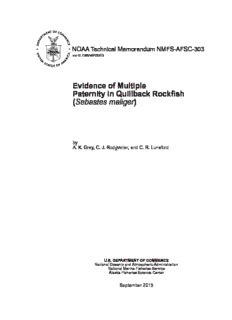
Evidence of Multiple Paternity in Quillback Rockfish PDF
Preview Evidence of Multiple Paternity in Quillback Rockfish
NOAA Technical Memorandum NMFS-AFSC-303 doi:10.7289/V5PZ56T3 Evidence of Multiple Paternity in Quillback Rockfish (Sebastes maliger) by A. K. Gray, C. J. Rodgveller, and C. R. Lunsford U.S. DEPARTMENT OF COMMERCE National Oceanic and Atmospheric Administration National Marine Fisheries Service Alaska Fisheries Science Center September 2015 NOAA Technical Memorandum NMFS The National Marine Fisheries Service's Alaska Fisheries Science Center uses the NOAA Technical Memorandum series to issue informal scientific and technical publications when complete formal review and editorial processing are not appropriate or feasible. Documents within this series reflect sound professional work and may be referenced in the formal scientific and technical literature. The NMFS-AFSC Technical Memorandum series of the Alaska Fisheries Science Center continues the NMFS-F/NWC series established in 1970 by the Northwest Fisheries Center. The NMFS-NWFSC series is currently used by the Northwest Fisheries Science Center. This document should be cited as follows: Gray, A. K., C. J. Rodgveller, and C. R. Lunsford. 2015. Evidence of multiple paternity in quillback rockfish (Sebastes maliger). U.S. Dep. Commer., NOAA Tech. Memo. NMFS-AFSC-303, 25 p. doi: 10.7289/V5PZ56T3. Document available: http://www.afsc.noaa.gov/Publications/AFSC TM/NOAA-TM-AFSC-303.pdf. Reference in this document to trade names does not imply endorsement by the National Marine Fisheries Service, NOAA. NOAA Technical Memorandum NMFS-AFSC-303 doi:10.7289/V5PZ56T3 Evidence of Multiple Paternity in Quillback Rockfish (Sebastes maliger) by A. K. Gray, C. J. Rodgveller, and C. R. Lunsford Alaska Fisheries Science Center Auke Bay Laboratories 17109 Pt Lena Loop Rd Juneau AK 99801 www.afsc.noaa.gov U.S. DEPARTMENT OF COMMERCE Penny. S. Pritzker, Secretary National Oceanic and Atmospheric Administration Kathryn D. Sullivan, Under Secretary and Administrator National Marine Fisheries Service Eileen Sobeck, Assistant Administrator for Fisheries September 2015 This document is available to the public through: National Technical Information Service U.S. Department of Commerce 5285 Port Royal Road Springfield, VA 22161 www.ntis.gov Abstract Multiple paternity, also termed polyandry, is a reproductive strategy that can increase the genetic variation within a brood to help preserve diversity within a population. A paternity analysis using multilocus microsatellites revealed that 8 of 25 (32%) quillback rockfish (Sebastes maliger) females mated with more than one male. Of the eight broods sired by multiple males, three were sired by two males and five were sired by three males. Polyandry is likely an important consideration when managing rockfish stocks for genetic diversity and productivity. The probability of polyandry increased with increasing weight and condition factor of the female, but not with increasing age or length. These results suggest polyandry is a common mating strategy in quillback rockfish in Alaska and may be related to female size. iii Contents Introduction ....................................................................................................................... 1 Materials and Methods ..................................................................................................... 3 Sampling ................................................................................................................. 3 Genotyping .............................................................................................................. 4 Data Analysis .......................................................................................................... 5 Results ................................................................................................................................ 6 Discussion........................................................................................................................... 7 Acknowledgments ........................................................................................................... 11 Citations ........................................................................................................................... 12 v Introduction Rockfish, Sebastes spp., are a diverse genera of over 60 species distributed along the northeast Pacific Rim. They are viviparous with internal fertilization and larval development (Love et. al. 2002), and are able to hold sperm after mating for later fertilization (Gunderson 1971, Sogard et al. 2008). Recently, molecular techniques have identified multiple maternity within a brood, also termed polyandry, in rockfishes (Ng et al. 2003, Hyde, et al. 2008, Sogard et al. 2008, Van Doornik et al. 2008). Polyandry is a reproductive strategy that can increase the genetic variation within a brood and help preserve gene diversity within a population. Some rockfish species, but not all, have shown to be polyandrous (e.g., Hyde et al. 2008, 10 of 17 species). Although quillback rockfish have not been examined, polyandry has been found in rockfish species closely related to quillback rockfish, including captive grass rockfish (S. rastrelliger) and wild kelp rockfish (S. atrovirens), while polyandry was not detected in the closely related wild brown rockfish (S. auriculatus). These findings suggest that polyandry may vary between closely related rockfish species. Maternal age and size is related to the rate of multiple maternity in Pacific ocean perch (S. alutus); monogamous females were significantly smaller and younger than polyandrous females. Besides polyandry, larval growth and survival has also been shown to be related to a higher maternal age (Berkeley et al. 2004, Sogard et al. 2008). These types of correlations are important to understand in rockfish because, if they exist, population viability and productivity may be influenced by the number of older, larger females in the population. This may have effects on the modeling of fish populations as most population models assume equal reproductive success for all sizes and ages of mature fish (Spencer et al. 2007). Quillback rockfish are exploited by commercial and recreational fishing and, in certain areas, they are subject to high exploitation rates (DFO 2012). (In fact, the Washington Department of Fish and Wildlife listed quillback rockfish as depleted in south Puget Sound and vulnerable in north Puget Sound (Palsson et al. 2009), the Department of Fisheries and Oceans, Canada, initiated a rockfish conservation strategy that included increased monitoring and research of quillback rockfish, and a review of quillback rockfish along the Pacific coast of British Columbia (Yamanaka et al. 2006) prompted the Committee on the Status of Endangered Wildlife in Canada (COSEWIC) to list British Columbia quillback rockfish as a threatened in 2009 (COSEWIC 2009, DFO 2012).) Because they are caught by hook and line, which selects for larger fish, high exploitation can result in age or size truncation and potentially a decrease in productivity (Gunderson 1977, Love et al. 1998, Berkeley and Markle 1999). If polyandry is linked to maternal size and age, like in Pacific ocean perch (Van Doornik et al. 2008), over exploitation of larger, older females could result in a loss of genetic diversity. Additionally, quillback are long-lived (up to 90 years, Munk 2001) and late to mature (between the ages of 5 and 22 years, Love et al. 2002), which makes them slower to rebound from population declines than fish that have faster growth rates and earlier onset of reproduction. 2
Description: